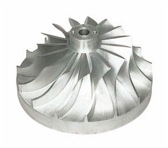7 Tips For Milling Complex Parts
 Many CNC machine shops have discovered that diversifying into new industries and, consequently, expanding the kinds of parts they produce is a key to growth in good times and a way to survive when the economy suffers. In many cases this means breaking out of their comfort zones and taking on more challenging work. When a company that traditionally makes fairly simple parts expands into aerospace, medical or other markets that have more complex and closer tolerance parts, they need to carefully consider what it takes to compete.
Many CNC machine shops have discovered that diversifying into new industries and, consequently, expanding the kinds of parts they produce is a key to growth in good times and a way to survive when the economy suffers. In many cases this means breaking out of their comfort zones and taking on more challenging work. When a company that traditionally makes fairly simple parts expands into aerospace, medical or other markets that have more complex and closer tolerance parts, they need to carefully consider what it takes to compete.
Gosiger 3-D Applications Engineer Brian Stall offers these tips for milling complex parts:
- Study the part carefully so you can develop a strategy for machining. The goal is to make the part with the fewest setups, operations and operator intervention. You’ll also want to establish procedures that will eliminate or reduce any variances from part-to-part.
- Although Computer Aided Design (CAD) and Computer Aided Manufacturing (CAM) are helpful, the CAM files should be seen as a starting point for developing your strategy. Often you can improve on the CAM procedures by making adjustments to better match your specific equipment and applying your experience with similar parts.
- Consider the size and features of the part to determine the best approach. Ask yourself, for example, “What do these features tell me in terms of possible tool deflection or distortion?”
- Another critical factor is the material you use to make the part. For instance you may need to consider special tooling if you’re working with exotic alloys or other hard to machine metals. You’ll also need to think about the different kinds of tools required for various features, and the tool holding capacity of the machine tool.
- Once you have a good handle on the part features and what is required to achieve them, you can group similar operations together to reduce the number of times a part must be repositioned.
- In many cases the ability to competitively produce complex parts requires CNC machining centers with multiple axes and functions. Simultaneous 5-axis machining centers are often the best choice, because they enable users to machine many complex parts in one setup, and eliminate the need to move parts from one machine to another.
- Because machining complex parts is so complicated, the CNC machine you use must have the fundamental capabilities to maintain accuracies while performing diverse functions. Things to look for in a machine include: A rigid spindle and tool holder to eliminate the vibrations and cutter run-out that cause out-of-tolerance parts; the ability to maintain constant spindle speed; a machine control system that maintains consistent acceleration and deceleration within the desired machine tolerance, that can quickly process data while communicating to drive encoders even faster, and that provides 3-D movement tracking and simulation.
Watch the video below of a 160 mm Impeller machined on an Okuma MU-500VA, 5-axis vertical machining center, programmed by Brian Stall with Esprit and using Sandvik Coromant tooling, along with SuperNurbs, TCPC, and TCPC II options.
Brian and other Gosiger applications experts regularly help customers find the best ways to machine complex parts and grow their businesses. Contact Gosiger today to learn more.